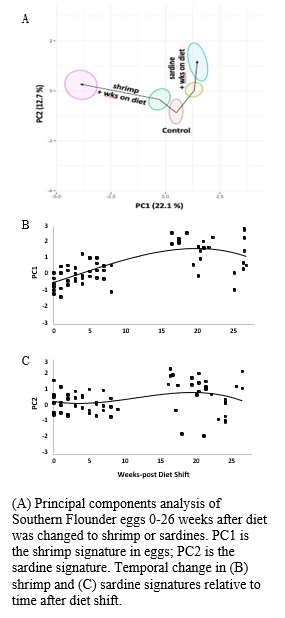EGG QUALITY AND THE TIMING OF BROODSTOCK DIET SHIFTS IN SOUTHERN FLOUNDER Paralichthys lethostigma
Egg and larval quality can be influenced by broodstock diet even when larvae are reared under uniform conditions and fed a high-quality diet. A study was conducted to determine how selected broodstock diets affect southern flounder (Paralichthys lethostigma) egg quality (fecundity, egg viability, hatching length, hatching rate) and to determine when broodstock diets should be changed to influence egg fatty acid content, which affects egg quality.
Southern flounder broodstock were fed one of four diets: (1) shrimp, squid, and mackerel (2:1:1 by wet weight) plus a nutritional supplement (Mazuri Gel) year round (SCT diet); (2) the same diet with the nutritional supplement given 1 month before spawning (MDC diet); (3) shrimp and sardines (1:1) until 16-26 weeks before spawning then shrimp only (shrimp diet) or (4) shrimp and sardines (1:1) until 16-26 weeks before spawning then sardines only (sardine diet).
After hormone injection, adults were strip-spawned, eggs incubated under uniform conditions, and egg quality was assessed. Fatty acid compositions of broodstock diets and eggs were analyzed by gas chromatography.
One-way analyses of variance revealed significant differences among treatments in larval hatching length (P < 0.05), with significant differences among all pairs of treatments except sardine vs. MDC (P = 0.49). No significant differences were observed for fecundity (P
= 0.08), egg viability (P = 0.63) or hatching rate (P = 0.06).
To assess timing of dietary changes on egg composition, data for the shrimp and sardine diets were combined with data from a prior study that used the same methods. Principal components analysis of fatty acid profiles separately characterized the shrimp and sardine signatures in eggs. The shrimp signature increased continuously 2 to 8 weeks after the diet shift and stabilized by 16 weeks. The sardine signature was apparent only 16 weeks or more after the diet shift.
These results can be used to develop more efficient broodstock feeding regimes that improve egg quality.
